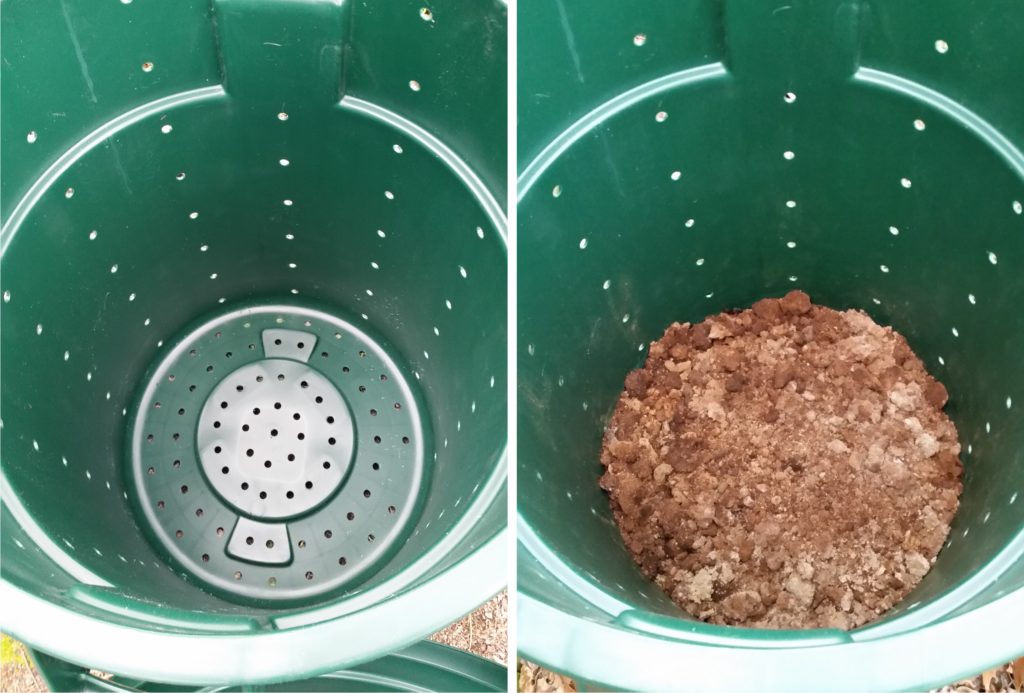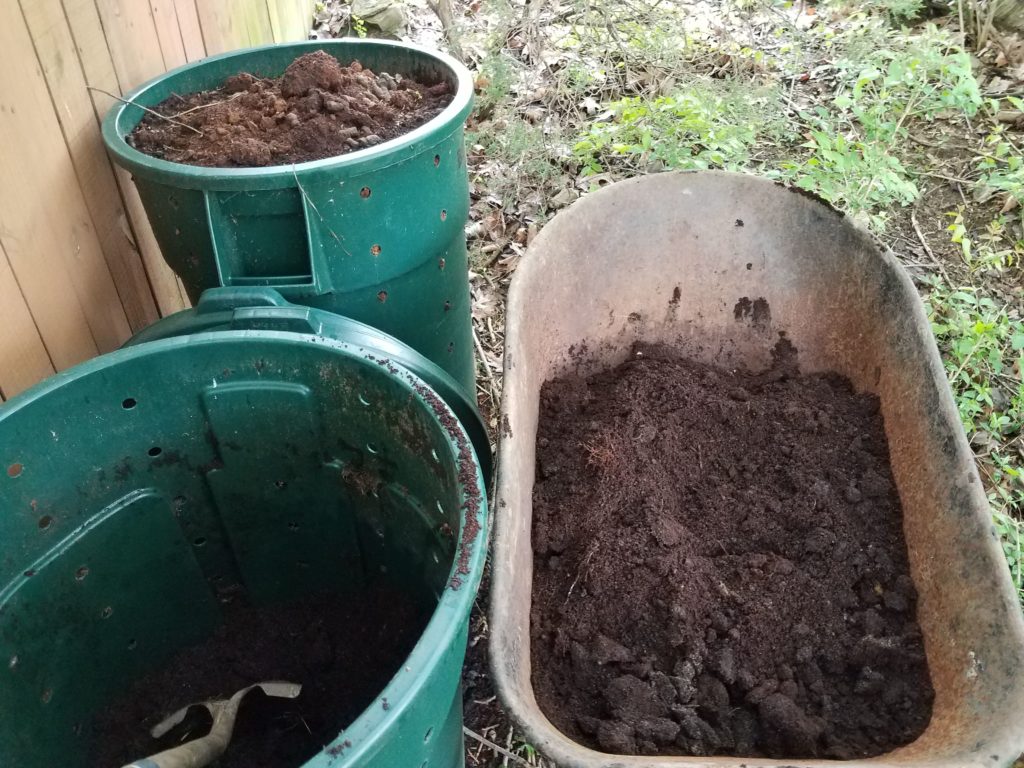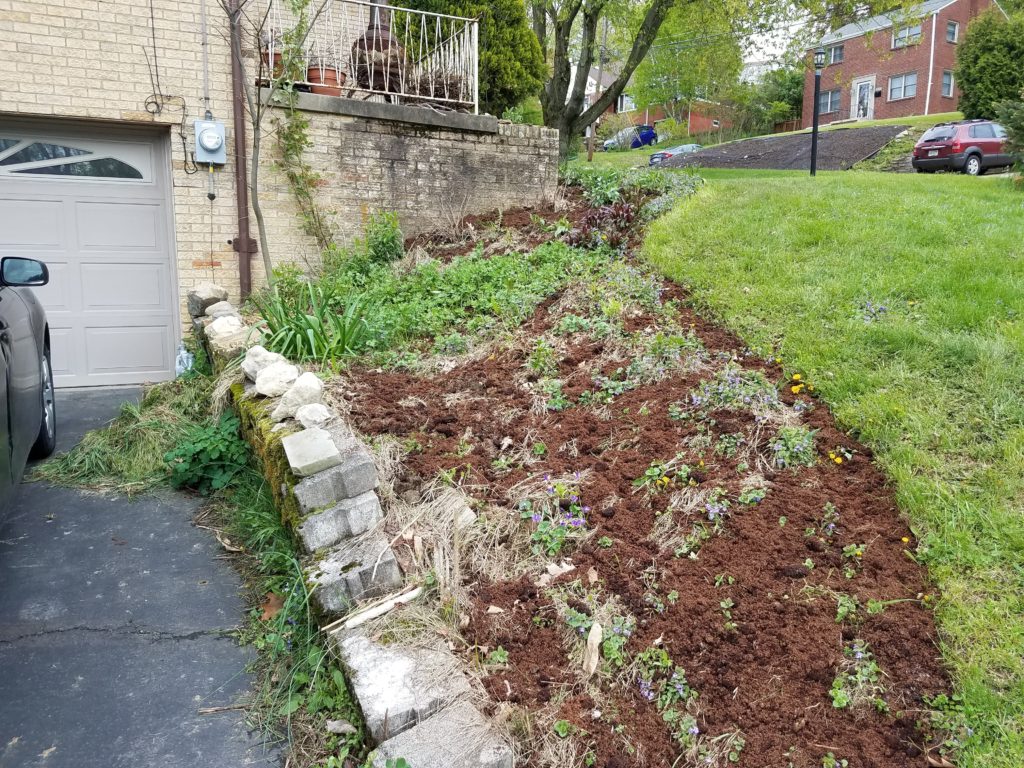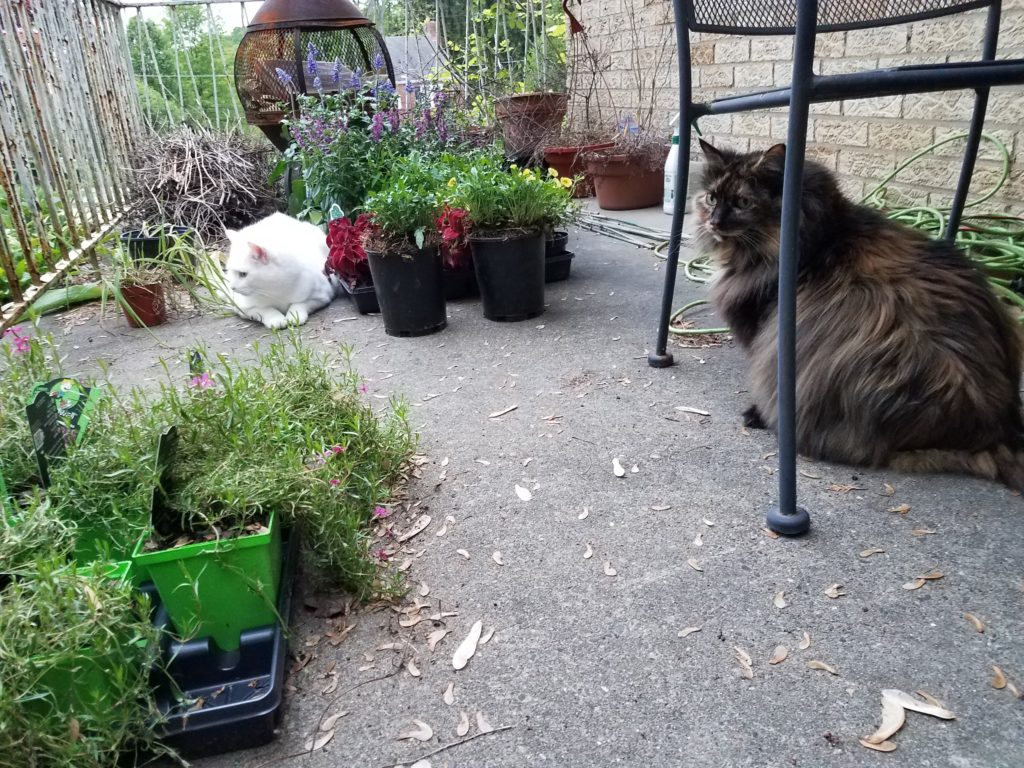About three years ago I could no longer stand the thought of sending a full grocery bag of used kitty litter to the landfill every week or so. At that point, I seriously started researching the topic of composting pet waste to offset our kitties’ carbon footprint. Despite many websites that say it is something you should never do, it is possible to do it as long as you do your research and follow some very specific guidelines.
Compost basics
Backyard composting is very easy to do once you get it set up and working properly. The idea is that biological material will break down in the presence of oxygen and water, and the end result is a beautiful, nutrient-rich material that can help improve your garden, reduce your need for chemical fertilizers, and lower your carbon footprint. The EPA has some great information if you’re interested in starting your own compost pile from kitchen or yard scraps.[1]
Optimal conditions involve just the right balance of carbon and nitrogen in the materials that are to be composted. In a standard backyard bin, you need to add “greens” and “browns” from your kitchen and/or yard. Greens are high-nitrogen materials, such as fruit peels, vegetable cuttings, or fresh grass clippings. Browns are high-carbon materials, such as straw, shredded newspaper, and dead fall leaves. It is important to note that backyard bins do not get hot enough to break down animal products (e.g. meat, dairy, bones), with the exception of egg shells. Commercial compost bins get hotter and can therefore break down bones, grease, and compostable plastic serviceware – don’t put those in your backyard bin.

The target ratio is roughly one-to-one for volume of greens and browns, which makes it easy to eyeball when you’re adding materials to the bin. You can tell if the ratio isn’t right by the temperature and smell of the compost. If the compost is very smelly and hot, it means you have too much green material; if it is cold and doesn’t seem to be activated, you have too much brown. Ideally, you should be turning your compost weekly to introduce oxygen, so this time provides a good opportunity to take stock of the condition of your compost.
There are several different types of bins available, but some of the best ones (in my opinion) are set on the ground with an open bottom so bacteria and beneficial creatures, such as bugs and worms, can come and help transform your scraps into something useful. There should also be some air holes on the sides of the bin to help with the introduction of oxygen.
Biodegradable/Compostable Litter
I had made myself a little kitchen-sized compost bin for my cooking scraps when I lived in my apartment, but there was nowhere to take the compost, so that experiment was short-lived. When I moved in with Christian and had a whole yard to play with, I took up the cause anew, planning to compost and garden to my heart’s content.
Our big kitchen compost bin was slow to fill up, and my thoughts returned to our kitty litter, which was made of crushed walnut shells and advertised as biodegradable. I originally switched over from clay litter years before to lessen Siegfried’s impact, but not with the intention of composting his waste. The packaging on the bag said that it was biodegradable, which had to be better for the environment than clay, or so I figured.
For the most part, any “sustainable” alternative that goes to the landfill isn’t going to do much good in there. Compostable plastics, walnut shell kitty litter, and even your food waste will not do the environment any favors if they go to a landfill. Landfills rely on anaerobic bacteria to break down garbage, which creates methane. If you’re putting something in the garbage, chances are it will result in landfill gas, which contains the potent greenhouse gas, methane.

Composting relies on aerobic bacteria, which does not create methane when breaking down organic material. When comparing composting and landfilling, composting will reduce your carbon footprint in multiple ways, namely by cutting down on the greenhouse gases produced by 1) transportation of your waste to the landfill and 2) decomposition in the landfill, in the absence of oxygen.
There are several different types of kitty litters that are biodegradable or compostable. Some of the leading brands are made from walnut shells, pine shavings, ground corn, and newspaper pellets. Ultimately, many sources suggest that your best option (if you’re not going to compost) is to switch away from clay to a flushable litter and dispose of the kitty waste in the toilet. (Note: Be sure to check with your municipal water authority first to make sure their processes eliminate the pathogens that you may be flushing.)
Concerns
There were two big concerns I encountered in my research: the first was the possibility of parasites in our kitties’ waste, and the second was the possibility of the walnut shells themselves harming plants in the garden.
Never put animal waste in your regular compost bin, but rather keep it separate. All animal waste has the potential for parasites, so you should always be careful when composting it. Cats in particular can be host to a particularly concerning one called toxoplasmosa gondii, which can cause birth defects if contracted by a woman who is pregnant. It has also been correlated with schizophrenia. It’s a fascinating creature, and RadioLab did an amazing piece on it, which I would highly recommend checking out.[2]
Some sources say that pet waste should not ever be composted because of the parasite risk. That being said, other sources provide instructions for how to do it safely. Research I found indicates that composting cat waste at a high enough temperature for a sufficient amount of time provides the right conditions for the parasites to die off. What these conditions are seem to vary by source, unfortunately, but regardless, no matter how careful you are, compost made from animal waste should never be put on food plants.
The article I originally referenced three years ago when starting this experiment dictated a two-year rest in the compost bin to allow time for pathogens to die off. I could not find that article to reference here. Some sources I did visit when writing this post said nothing about time limits. PetMD states that temperature is the important factor and that the pile should get up to 145°F to kill the pathogens.[3] I wouldn’t recommend sticking your kitchen thermometer in the pile to be sure, but you can always add more nitrogen-rich material to get it moving if it seems cold.

The second concern was that of the walnut shells. Many gardeners know that walnut (particularly black walnut) can be damaging to other plants. Black walnut trees produce a chemical compound called juglone. It is damaging to some plants, which gave me pause when considering whether or not to use walnut shell-based kitty litter as garden compost. I do not know if the walnut shells used in the kitty litter I buy come from regular or black walnut, but I have heard anecdotal evidence from people in my family who grew up on farms that no other plants would grow under or near their walnut tree(s).
An article from the University of Iowa extension indicates that juglone will break down in two to four weeks with exposure to air, water, and bacteria. [4] I reasoned that a one-year-plus composting time would be sufficient to deal with the juglone risk. In any case, many of the plants sensitive to juglone (listed in this article) are food plants, such as tomatoes, peppers, and eggplant, which shouldn’t come into contact with the kitty compost anyway.
Process & Results
Indeed, much information available online seems to be anecdotal, as is this post. My intention here is not to say with definitive certainty that this process is fool-proof, but rather to tell you the reader what I have done and how it has worked for me.
My first step was to purchase a 55-gallon plastic trash bin. I then drilled holes in the sides and bottom to allow for bacteria and airflow. Once the bin was set up outside, I started taking kitty waste to the bin instead of dumping it in the garbage. I keep a couple sealable plastic coffee canisters near the litter boxes so I can put the waste in them and then empty them in the compost once a week instead of every time I clean the boxes.
It took a year to fill up the first bin, at which point I purchased the second one and set it up the same way. At some point I decided to wait one year instead of two (or perhaps misremembered the timeframe suggested in my initial research.) In any case, we have hit a nice rotation where it takes the kitties one year to fill up one bin, and then everything in that bin will compost for one year while they fill up the other one. In the spring, I empty out the bin that has been sitting for a year, use that compost on the garden, and then start filling it back up while the other one sits.

As I mentioned, this is a multi-year project in the works, and it is still ongoing as I watch for any impacts on my garden, positive or negative. I haven’t been able to determine an impact yet, but I only started planting flowers last year after more than a year of weeding, tilling, and prepping. Our ground is almost solid clay, so I have had to dig out beds, break up clay, and refill the space with topsoil and compost (not our own – 55 gallons is much less than it sounds like).
Spreading the whole compost bin results in a very thin coating across my entire garden bed. I’m not sure it is providing much benefit to the flowers at this point, but it is providing me much peace of mind knowing that it’s waste that isn’t going to the landfill.
Do you compost? Do you compost pet waste? Is it something you’ve wanted to try or have questions about? I’d love to hear your comments below!
[1] https://www.epa.gov/recycle/composting-home
[2] https://www.wnycstudios.org/story/91692-the-scratch
[3] https://www.petmd.com/cat/care/are-there-eco-friendly-cat-litter-disposal-options
[4] https://www.extension.iastate.edu/news/2005/jul/070701.htm
6 Comments
Stephen M. Smith · November 6, 2020 at 12:05 am
Thank you! This was very helpful. I have started using walnut shell litter and I was not wanting to send it to a landfill. This article was exactly what I needed to get a composting system going. Thanks again!
Alison · November 7, 2020 at 9:11 am
Thanks Stephen, I’m glad you found it useful!
I’ll be curious to hear how it works out for you… in a year or so.
Shayn Ember · November 16, 2020 at 6:39 pm
Thanks for this article! I am curious to try this exact process (using walnut litter, waiting a year). It looks like it has been over a year since you posted… how are your plants doing in the compost material?
Alison · November 16, 2020 at 7:53 pm
Plants are doing well! The walnuts didn’t break down as much as I had expected (but I was also very bad about turning the compost regularly!)
It turned out to be a good mulch, and none of my plants have suffered from the presence of the walnut, as far as I can tell.
Kristin Hurst · March 21, 2022 at 1:53 pm
Thank you for the great read! I started composting with walnut cat littler 2 years ago and I am ready to put it to work. I am the crazy cat lady with four cats and they can sure add up in littler.
Alison · March 27, 2022 at 12:56 pm
Thanks, Kristin!
Hope it goes well – feel free to check back in here and share your results!